Monstrous struggle of perseverance and resilience
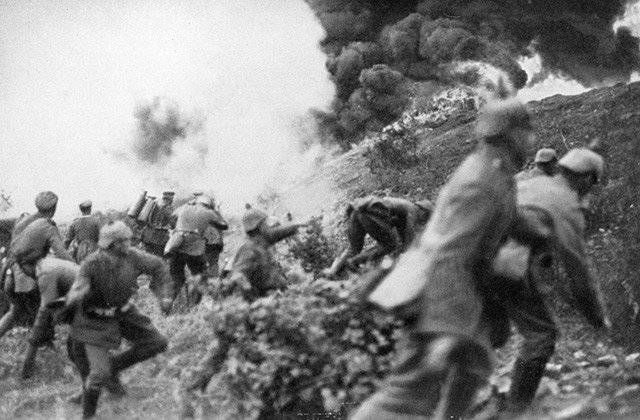
Verdun - the mass grave of the best sons of France and Germany
The Battle of Verdun holds a special place in stories Great war, and for the French the name of this small town is almost almost sacred. It is in the vicinity in 1916 year solved the fate of France, where over 6 months, German troops almost without interruption stormed the position of the French, alternating monstrous in power shelling, many times dug square kilometers of land interspersed with human remains, with fierce melee, after which in broken trenches without exaggeration flowed streams of blood. But the French, at the cost of tremendous sacrifices, survived, disrupting the plan of the German General Staff for forcing the country to surrender. And the German army lost near Verdun not only the core of its army - field veterans hardened in battles, it lost something more - the unconditional faith in its impending victory.
Since then, Verdun was awarded a huge number of epithets - "the capital of glory", "symbol of courage", "bastion of freedom", etc. It was the ashes of one of the defenders of Verdun who was buried in the first in world history Tomb of the Unknown Soldier, which was solemnly opened in Paris in 1920 year. The battle of Verdun entered the world history as one of the brightest symbols of the First World War, becoming the personification of all its horrors. It is not by chance that its second name is “Verdensky meat grinder”. And the memory of that tragedy in France is all the more forceful because the World War II for it, which is much more bloody for other countries, was almost "in passing."
"Immature strategy is the cause of sadness"
This maxim of the ancient Chinese sage Confucius can be safely used as an epigraph to the strategic plan of the Verdun operation.
The fortress of Verdun was created by the French in the 18th century as the main stronghold, covering the shortest route to Paris from the east for the hypothetical German offensive. According to some military experts, Verdun was the most echeloned and largest fortress in Europe. During the Franco-Prussian War 1870-1871 Verdun managed to hold out against the pressure of the Prussian troops for about six weeks. By the beginning of the battle, the Werden fortress was already a rather conventional name - in fact it was a powerful fortified area of almost 100 km, including a chain of forts and field fortifications connected by a complex underground passage and communications system that covered the horseshoe from the north and east at 5 -7 km.
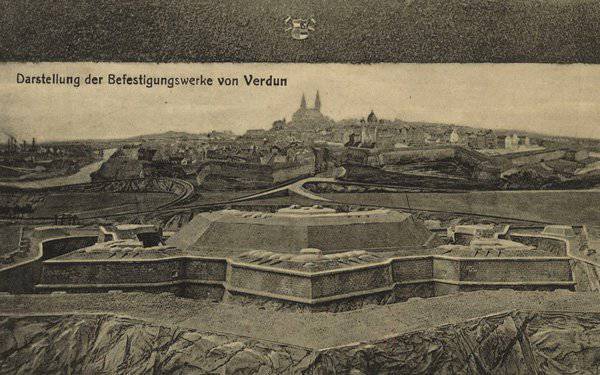
The idea of storming one of the most powerful forts in Europe in the forehead, while storming it in the most difficult sector, belonged to the chief of the German General Staff, Erich von Falkenhayn. Such a decision was not an indicator of the strategic infantilism of this outstanding German military theorist. Quite the contrary - the idea of storming Verdun became a logical, final point in the long chain of Falkenhayn's analytical thoughts, made on the basis of a scrupulous analysis of intelligence on the French army, references to the economic and socio-political state of France.
The strategic concept of ensuring the victory of Germany in the Great War, which was defended by the chief of the German General Staff, was based on the recognition of the German Western Front as much more important than the “Russian” Eastern Front. If it were not for Helmut von Moltke (junior), namely von Falkenhayn, who would have headed the German General Staff from the first day of the Great War, it is highly likely that France would have been crushed already in the 1914 year.
Had Falkenhayn in August 1914 of the highest German military post, despite any Russian efforts in East Prussia, not a single German compound would have been withdrawn from the Western Front, and the famous Schlieffen Plan — for the rapid defeat of France — would be rigorously executed. From a politico-military point of view, the Germans were extremely unlucky that the soft, prone to compromise solutions von Moltke Jr. was in the days of the fateful battle for Marne at the main helm of the German military machine. As a result, by the end of 1914, it turned out that the Schlieffen Plan was also failed due to the urgent movement of troops to fight the Russians in East Prussia, and the Russian army, although it was knocked out from under Koenigsberg, but continued to advance in other sectors .
At the beginning of 1916, France, according to General Falkenhayn, both militarily and in socio-economic terms, has already reached its limits. Only a powerful final effort was needed, the chief of the German General Staff believed to convince the French of the meaninglessness of further struggle. To solve this problem, in view of the limited German resources, there was no need to organize a large-scale strategic offensive; one large local operation within the framework of a “strategy with limited goals” was enough. Such an operation could be an attack on Verdun: a large operational “pump for pumping blood of the French army” was to be created here.
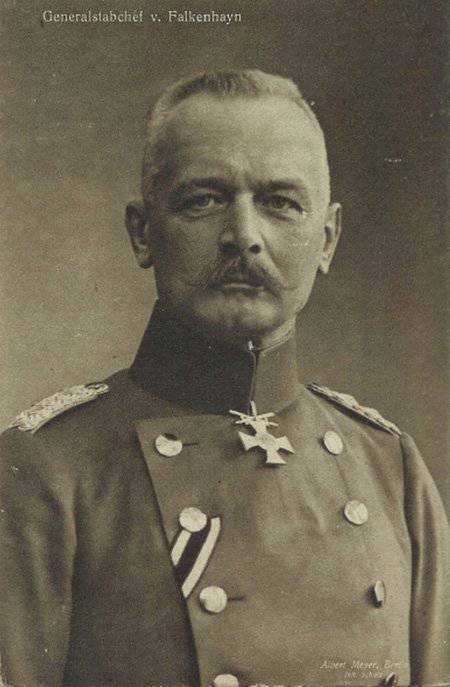
The German General Staff was skeptical about the value of the long-term fortification, it was believed that the German heavy artillery, applied massively on a limited area of the front, was able to "open the gates" in any defense. Considering the disposition of the coming offensive only from this point of view, the Germans narrowed down the front of the breakthrough to a minimum. According to Falkenhayn, this would allow the attacking German infantry to get maximum support from artillery.
“A strategy with limited goals” naturally predetermined the locality of the main operational task. The German General Staff did not plan for a decisive hack of the French defense to its full depth (and, accordingly, a breakthrough to Paris) - von Falkenhayn believed that this goal could not be achieved anyway. German soldiers and officers were only asked to “open the gates, but not to enter them,” with the goal of engaging more and more contingents of the French army “to shut the doorway with their bodies”, i.e. engage the counterattacking French under the disastrous fire of German batteries.
According to this decision, the area of the main German attack near Verdun was limited to a front of about 10 km, from the Meuse River to the Azan-Orn-Danlu Road. There was, however, the direction of the auxiliary attack, which was sent from the west - from the town of Etienne on the Vevre plain, but this direction had no significant operational significance.
Von Falkenhain’s pessimistic view on the possibility of a decisive overcoming of the main French defensive line and a breakthrough to Paris was the main cause of the senselessness of the colossal victims of the German army at Verdun. She lost, not because she could not win, but because her initial strategic deployment did not imply victory.
The point of view of the Chief of the General Staff on the strategic plan of the operation at Verdun, as was the case in the highest echelon of the German generals, was not the only one. Erich von Falkenhayn was strongly opposed by a prominent General Staff officer, General Heinrich von Bauer. He argued that the experience of fast, rapid seizures of such major Russian fortresses as Kovno and Novogeorgievsk, testifies to the effectiveness of massive, territorially significantly broader operational coverage.
Bauer suggested that the strategic goal of the Verdun operation was not to create a hypothetical “pump for pumping blood of the French army”, but rather a specific and quick, within one or two weeks, seizure of the Verdun fortress. To this end, the breakthrough front had to be significantly increased: the blow from the north had not to be limited to the right bank of the Meuse, but to develop it simultaneously on the 22 front kilometer on both banks of this river. But the proposal of General Bauer has not received development. This was, apparently, the main reason for the Germans ’strategic fiasco near Verdun.
First success
The German forces involved in the Verdun direction, if they outnumbered the French units, were very insignificant. A significant predominance of German troops was created only at the turn of the proposed breakthrough: around 6,5, the German divisions versus two French divisions (on February 21 1916 of the year). Subsequently, the number of the opposing forces, even at the turn of the main attack, was almost equal, and in the first decade of March the French had near Werden almost one-and-a-half superiority in manpower.
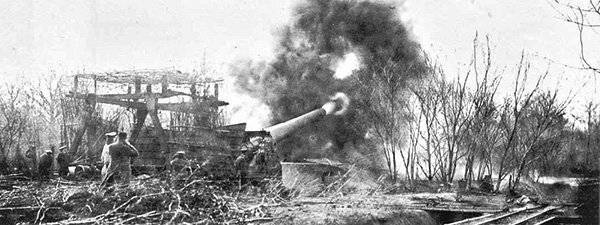
The German General Staff attached great importance to ensuring the protection of advancing soldiers from air attacks. To counteract the French airplanes, the Germans deployed several field airfields in the front-line zone and concentrated very significant air force assets at that time — 168 airplanes, most of which were fighter-type.
Fundamental importance was also attached to the concentration of artillery fire in the area of the breakthrough, especially large-caliber artillery. On the day of the start of the Verdun operation - February 21 of the year 1916 - Germanic 946 guns, of which 500 are heavy, opened massive fire on French positions. Artillery preparation continued at an intense pace around 9 hours.
After the completion of the artillery barrage, the Germans went on to break through the French fortifications in dense military formations. The advancing divisions had two regiments in the first line and one regiment in the second. The battalions in the regiments attacked 400-500 sections of meters and were built in a layered manner. Each battalion created three chains moving at a distance of 80-100 meters from each other. The advanced chains of the attackers relied on special assault groups formed of well-trained soldiers, reinforced by machine-gun and flame-throwing calculations.
It should be emphasized that all sides of the Verdun meat grinder, both sides, but with special intensity the Germans, used poison gases, both with the help of the usual “balloon” attacks and with the help of chemical projectiles. Also for the first time on a large scale the Germans used battalion flame throwers, all in the breakthrough area - 96 installations.
The massive onslaught of well-trained German regiments, as predicted by General Bauer, led to remarkable success in the very first days of the offensive. By February 25, i.e. in less than four days, the German troops not only crossed the 8 kilometers depth strip, which the French turned into the most difficult fortification line during the 18 months, but also captured the most important northern fort of Verdun - Duamon. In addition, the Germans were able to relatively easily capture a number of forts and fortified villages.
However, the calculations of Erich von Falkenhayn on the reckless engagement of significant contingents of French troops in the elimination of the German breakthrough did not materialize. The French themselves did not hurry to attack the positions already captured by the Germans, but with fervent, even fanatical persistence, fought to retain those lines that still remained under their control. The one-sided “pump”, which would only pump out the blood of the French army, clearly did not work, but a terrible mutual “pump” was formed, which destroyed the male population of Germany and France with methodical efficiency.
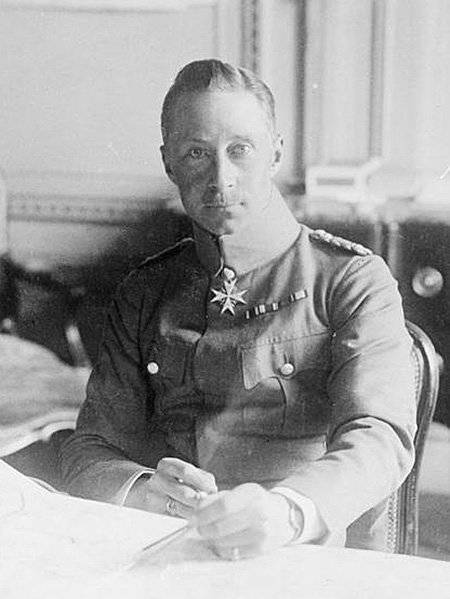
The French command took the most energetic measures to stop the advance of the German troops. The 6 000 vehicles, including Paris mobilized taxis, were sent to the German breakthrough site by a continuous stream of troops on the only highway linking Verdun to the rear, 6 of thousands of soldiers and 190 of thousands of tons of military cargo were delivered to 25 in March.
On the left bank of the Meuse River, the French deployed a very strong large-caliber artillery position and began to continuously fire at the German breakthrough area from the flank and rear. Another warning from General von Bauer, not perceived by the German General Staff in time, began to come true: the narrow front of the offensive of the German troops did not allow the French artillery to escape the disastrous fire - even those German troops that were far enough from the front line, now suffered from tangible losses.
To be able to continue the operation, the German command now had to attack the left bank of the Meuse, which led to new large-scale losses, since the surprise factor had already disappeared, but positions on the left bank of the Meuse were jammed with French troops and numerous artillery. As a result, the auxiliary operation, which at the end of February 1916 would take a maximum of 2 days, now had to spend 5 weeks (from March 6 to April 9). These, almost a month and a half, the German troops fiercely fought for insignificant 6 km in the depth of the front along the Avokur line - altitude Mortom - Cumiere.
Having expanded at the cost of incredible efforts and great blood, the front of a breakthrough for a further offensive, the Germans, alas, could not carry it out. By mid-April, 1916, the German troops were extremely tired, they were required to rest, and some units and re-formation. At the front of Verdun there was a temporary lull.
"Meat grinder" at Fort
The outcome of the first stage of the Verdun operation was extremely dissatisfied with a significant part of the German generals, especially those military leaders who attributed the victory of Germany in the Great War, primarily with the top priority defeat of Russia. The chief of staff of the German Eastern Front, General Erich von Ludendorff, angered in the middle of May 1916, wrote to General Max Hoffmann: “I’m sorry for German families to which the sons were killed by Verden’s innumerable stream. All these tens of thousands of young destinies could be preserved in the battles in the east and, moreover, achieve significantly better results. ”
Crown Prince Frederick William — heir to the ancient throne of the Hohenzollerns — became the opponent of the Chief of the German General Staff, von Falkenhayn, on the Western Front. Kronprinz did not belong to the type of “boudoir” dignitaries, it was a highly professional, gifted with intelligence and will of a military leader, a typical representative of the inflexible “Prussian caste”.
Frederick William commanded on the Western front an army group "Kronprinz Wilhelm", which was at the very center of the front line. The feat and tragedy of the German troops at Verdun, the Hohenzollern heir saw with his own eyes and was very upset, so his verdict was unequivocal: the effect of surprise was long gone, the French would continue to fight to the death on both sides of the Meuse, the German losses became transcendent, and, consequently, the operation at Verdun must be terminated.
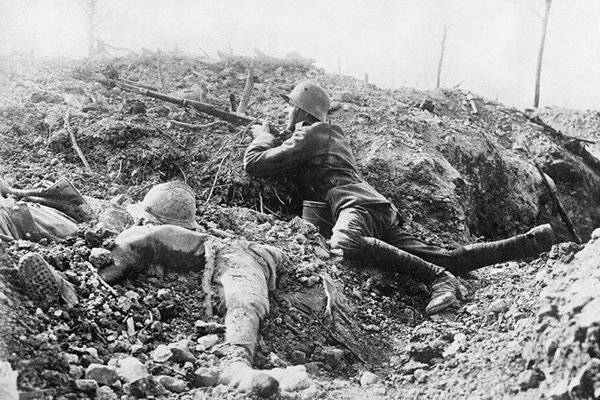
“The months of the battle of Verdun,” Crown Prince William later wrote in his memoirs, “are in my memory the most difficult of the entire war. I anticipated and knew the situation beforehand; I had too many personal meetings with officers and soldiers of combat units to indulge myself with illusions. In the depths of my soul, I was absolutely against the continuation of the offensive, and yet I was forced to execute the order of the offensive. ”
To the credit of Crown Prince Wilhelm, it should be emphasized that he repeatedly reported his opposition to the plans of Erich von Falkenhayn on the further continuation of the Verdun Meat Grinder to both the Chief of the German General Staff and his father, Kaiser Wilhelm II.
In the struggle of two conceptual positions on the continuation or termination of the Verdun operation, the opinion of the Chief of the General Staff of Germany eventually won. General Falkenhayn was able to convince the country's political leadership that the continuation of the battles at Verdun would exclude the connection of the military forces of the French and the British in the area of the Somme River.
The German General Staff possessed reliable intelligence data that the large-scale offensive of the Allied armies on the Somme would necessarily take place in the summer of 1916. Consequently, the chief of the German General Staff concluded, the Verdunian offensive makes sense to continue, at least until the phase of maximum offensive efforts of the Entente's armies on the Somme. With a heavy heart, Kaiser Wilhelm II was forced to sign an order for an offensive. The new directive of the General Staff ordered to capture Verdun before 15 June 1916 of the year.
2 June 1916, the German forces under the command of General Edvald von Lohova by forces of three army corps (1-th Bavarian, 10-th Reserve, 15-th Army) launched an offensive. The main attack was on the French defense lines, located on the right bank of the river Meuse. The offensive was supported by a powerful artillery position composed of 26 heavy mortars and 24 large-caliber howitzers. On the left bank of the Maas offensive actions were stopped. This was a forced decision for the German command, since the forces on both sides of the Meuse were simply not enough to strike simultaneously.
The attack was preceded by a two-day artillery preparation. According to the consumption of heavy shells - about 150 thousands of shots per day - it turned out to be one of the most intense in the battles of the Great War.
The Germans did not spare the shells, because otherwise it was meaningless to expect to seize the powerful fort of Vaud, as well as the last defensive line in front of Verdun, passing through the Fort Fleury - Fort Suvil - strengthening of the Frouad. The seizure of this line by German troops ensured the complete isolation of Verdun from rear support and in fact meant its surrender.
Especially heavy, very bloody battles turned around for the possession of Fort Wo. The German 10 Reserve Corps managed to completely cut off the fort from the rear support. However, the French did not capitulate: the commander of the garrison of the fort, Major Renal, categorically rejected General von Lokhov’s proposal to lay down weapon and pass the position. Fierce hand-to-hand fighting broke out on the fortifications broken by concrete-shell shells: the Germans and the French fought desperately and mercilessly, they did not take prisoners.
The Germans used against the garrison in literally all military-technical means: fire 420-mm guns, shells with poison gases, massive use of flamethrowers. However, the heroic fort held on. The besieged were even able to maintain contact, however, one-sided - with the help of pigeons - with the headquarters of General Henri Petain, who commanded the French troops near Verdun.
From the very first day of the encirclement of the fort W the commander of the 2 of the French army, General Nivelle was trying to organize a de-blockade of the fort. On the night of June 6, the last attempt was made to break the ring of the German blockade by the forces of the brigade Colonel F. Savi. Her fighters bravely rushed to the fort, the brigade fell almost all, but could not unlock W. German field guns shot the French assault lines with direct fire.
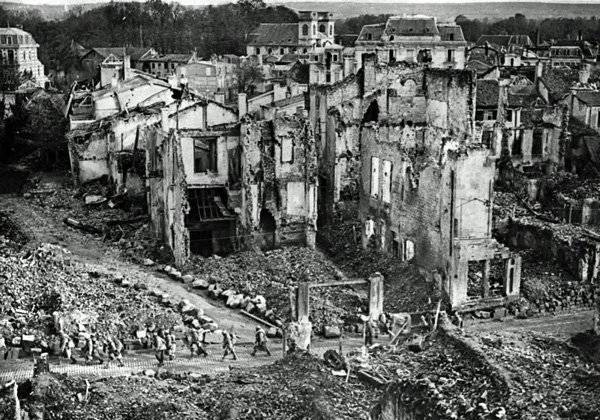
7 June 1916 y ode the last carrier pigeon from Fort Waugh arrived with a note written in blood. It was just a few words: "Long live France!". On that day, a handful of defenders of Vaud were captured - almost all French were injured, many could not hold a weapon in their hands. But the taking of the fort cost dearly to the German 5 Army, only the Germans who were killed here lost 2700 soldiers and officers.
In the next five days, the German units managed to build on their success. The French defense began to crack: the 2 and 6 corps of the French army, located at the Fleury-Tiamon border, i.e. on the edge of the German onslaught, lost over 60% of personnel. It is important to note that, despite the monstrous losses (in some companies with a regular number of 164 fighters remained no more than 30 people), the French held incredibly steadfast, sometimes with the cheerful audacity of the doomed.
At the turn of Fleury-Tiyaron, one of the most massive and brutal hand-to-hand fights of the Great War period took place these days, which went down in history as the "Bayonet battle in a trench."
In the pre-dawn fog several thousand German and French soldiers came together to the chest: the battle was fought with bayonets, butts, bayonet-knives and sapper shovels. According to eyewitnesses, after the battle the blood flowed through the trench - like melt water during high water, even around the sanitary tents the whole earth turned red.
23 June 1916 of the year to support the assault units of the German 5-th army arrived personally Kaiser Wilhelm II. He visited all the advanced regiments, inspected field hospitals, talked with many soldiers and officers.
The 23-25 period of June was the peak of German offensive activity in the Battle of Verdun. The last defensive line in front of Verdun - Fleury-Tiamon - was finally captured. It seemed that the victory of German perseverance over French perseverance was already close, but by the evening of June 25 the French had managed to powerfully counterattack the flank of the German breakthrough with the help of re-deployed fresh units. General von Lokhov, taking into account the exhaustion of the advance units, received the Kaiser’s permission to regroup his forces for the final blow at Verdun through Fort Suvil.
Maas mill of the German spirit
History (and, moreover, military history) does not tolerate, as is known, the subjunctive mood, but with a high degree of probability we can still assume that the final assault of Verdun by German troops in early July (if it took place under different conditions) would have been undoubtedly successful. However, 1 July 1916, the Anglo-French troops in a different sector of the front, in a decisive, well-prepared offensive, crossed the Somme River to the west. One can only imagine the fierce despair of General von Falkenhayne when he was forced to give an order to transfer several fresh divisions from under Verdun to hold the front on the Somme!
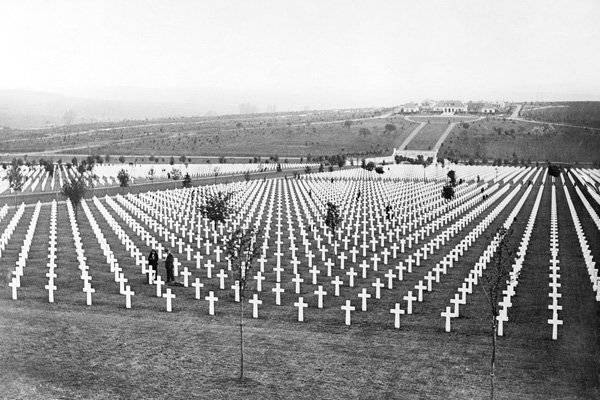
Increasingly, from 2 to 12 in July, German forces and large-caliber artillery were removed from the Verdun direction and transferred to the line of the new Anglo-French offensive. Apparently, in order to prevent a similar transfer of French troops from Verdun to the Somme, the commander of the German 5 Army, General von Lokhov decided to strike the French citadel again.
11 July 1916, the troops of the 10-th Reserve and Alpine corps in a desperate attack seized the key to Verdun - fort Suvil. From the top of this fort Verdun was clearly visible - the distance to the walls of the citadel did not exceed 4 kilometers. The top of Souville was ideal for placing an artillery position - in a matter of days the heavy guns of the German army, if they were installed in Suvila, would not leave the defenders of Verdins no chance of salvation.
However, everything has a limit. Generally von Lokhov, with all his desire, could no longer send any fresh troops to reinforce the assault brigades in Suvil — the commander of the German 5 Army simply did not have such units. As a result of a decisive counterattack, the French division of General Mangene was able to throw the Germans back to their original positions. This counterattack meant the actual ending of the bloody Verdun epic.
The German 5 Army, as of 11 in July, included 25 divisions, but the actual number of fighters in these divisions barely reached 30-50%. German soldiers were not just tired and spiritually devastated, they began to lose their sincere faith in the coming victory - a quality that was especially strong and valued by the German army.
“From now on, my last hopes were scattered,” crown prince Frederick William wrote bitterly about these days, “in this Verdun hell, even the bravest troops were not able to maintain their moral strength for a long time to continue the offensive. The Maasian mill crushed not only bones, but also the spirit of the troops. ”
Verdun, along with the unexpected for the German General Staff Lutsky (Brusilovsky) breakthrough of the Russian troops on the Eastern Front, drew a final line under the stay of General von Falkenhayn on the first most significant military post of the German state. On August 29, by the decree of Kaiser Wilhelm II, he was dismissed from the post of chief of the General Staff and sent to the front in Romania as commander of the 9 army. His successor was Field Marshal Paul von Hindenburg, the creator of the former victory over Russian troops in East Prussia.
The official history of the Great War regards the Battle of Verdun, along with the battle of the Somme, as a kind of line for which Germany lost its strategic initiative. One can reasonably argue with this statement. But it is absolutely indisputable that the Verdun meat grinder remained forever in the history of Europe as a terrible epic of the mutual destruction of the German and French peoples: only the losses killed and wounded for each of the parties amounted to more than 350 thousand people.
Information